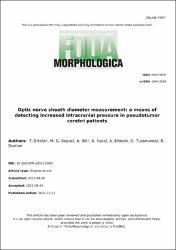Optic nerve sheath diameter measurement: a means of detecting increased intracranial pressure in pseudotumor cerebri patients

Göster/
Erişim
info:eu-repo/semantics/openAccessTarih
21.10.2021Yazar
Ertekin, TolgaBoyacı, Mehmet Gazi
Bilir, Abdulkadir
Yücel, Aylin
Ertekin, Ayşe
Turamanlar, Ozan
Duman, R
Üst veri
Tüm öğe kaydını gösterKünye
Ertekin, T., Boyaci, M. G., Bilir, A., Yucel, A., Ertekin, A., Turamanlar, O., & Duman, R. (2021). Optic nerve sheath diameter measurement: a means of detecting increased intracranial pressure in pseudotumor cerebri patients. Folia Morphologica.Özet
Background: Pseudotumor cerebri (PTC) occurs when the pressure inside the skull increases for no obvious reason. The aim of this study was to investigate three different methods: the optic nerve sheath diameter (ONSD) method, ONSD/eyeball transverse diameter (ETD) index, and ONSD/orbital transverse diameter (OTD) index for the initial detection of elevated ICP in patients with PTC.
Materials and methods: A retrospective study of MR data from adult PTC patients (n=42) and control group (n=40) was performed. ONSD and OTD measurements were made 3mm and 10mm posterior to the globe, after intracranial pressure was measured with lumbar puncture. The sensitivity, specificity, and overall accuracy of the findings on MRI were calculated.
Results: The optic nerve sheath was enlarged in the PTC group compared with the control group. It showed 97%sensitivity and 100% specificity and 79% sensitivity and 87.5% specificity for 3mm and 10mm, respectively. The ONSD/ETD and ONSD/OTD indices were increased in the PTC group compared with the control group. For 3mm posterior to the globe, the ONSD/ETD index had 90.5% sensitivity and 92% specificity, and the ONSD/OTD index had 86% sensitivity and 95% specificity. For 10mm posterior to the globe, the sensitivity and specificity of the ONSD/ETD and ONSD/OTD indices were 86% and 80% and 74% and 82.5%, respectively.
Conclusions: According to our study, the ONSD method and the ONSD/ETD and ONSD/OTD indices are reliable diagnostic markers for PTC. These noninvasive techniques may be useful in monitoring the invasive intracranial catheter and have wide potential clinical applications in district hospitals, emergency departments and intensive care units.















